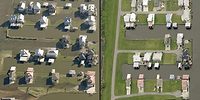HOUSTON — To help the millions affected by Hurricane Harvey and subsequent flooding in the state of Texas, Woolpert has collected, processed and delivered high-resolution, before-and-after aerial imagery within days of the disaster and made it available to the public today.
These maps, accessible at woolpert.com/harvey, enable viewers to navigate and enhance specific locations across Houston, offering what is believed to be the highest-resolution data available within this time frame, to precisely illustrate the impact of the flooding. It has been aggregated with data from the National Oceanic and Atmospheric Administration (NOAA) and Google to provide the most comprehensive product.
This imagery enables local, state and federal officials to identify specific areas most in need of resources and allows anyone with internet access the ability to check on neighborhoods, property damage, road closures, etc.
“There is an urgent need for accurate information regarding the physical aftermath of Harvey, and we are one of the few firms that can create, deliver and aggregate maps of this resolution in the abbreviated time frame necessary,” Woolpert CEO Scott Cattran said, adding that the national architecture, engineering and geospatial (AEG) firm has an office in Houston. “We knew this was something we could do to help our neighbors in Texas, so we mobilized quickly.”
Woolpert waited for the high-water mark to be reached in Houston on Friday, collected aerial imagery, flew the imagery back to its headquarters in Ohio, processed that data, and shared the resulting maps immediately to its public website and application, the latter of which has proved to be invaluable in the field.
This 1-foot imagery was paired with comparable imagery collected in 2016, and installed in a before-and-after online slider to easily identify dams, bridges, homes, workplaces, etc., affected by the disaster. Woolpert is conducting more aerial collections as weather allows to augment this imagery. These maps also will be adjusted manually over time to improve accuracy.
“To get the imagery this quickly, flown at less-than-ideal conditions with clouds and cloud reflections, it’s not as precise as it could be—however, timing took precedent for this collection,” said Cattran, adding that he was proud of his employees for giving their time to the cause.
This is the second time that Woolpert has donated this service to assist with disaster relief efforts. In October 2015, the firm flew, processed and posted perishable aerial imagery within hours of massive flooding in South Carolina. Members of the firm then remained on site to assist as needed.
Woolpert also has made its staff available to the Harris County Office of Homeland Security and Emergency Management, the City of Houston Office of Emergency Management (OEM), Houston Mayor Sylvester Turner, and other local, state and federal officials to further this effort.
Woolpert’s data is being shared with the National Alliance for Public Safety GIS Foundation (NAPSG), which has created a dedicated site to aggregate the “most relevant and best available data” to support response and recovery efforts in the aftermath of Hurricane Harvey. The effort was the request of Federal Emergency Management Agency (FEMA), the U.S. Department of Homeland Security (DHS) and the U.S. Department of the Interior (DOI). The Homeland Infrastructure Foundation-Level Data (HIFLD) site is at https://respond-harvey-geoplatform.opendata.arcgis.com/.

Report Abusive Comment